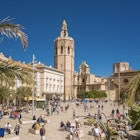
Valencia’s best beaches – get the morning sun before almost anywhere else in Spain

Oct 25, 2021 • 5 min read

Valencia’s best beaches are within easy reach of the city center ©nito/Shutterstock
In Valencia, you can roll rich culture, phenomenal food, and golden beaches into one fabulous city getaway. This east-coast city’s Mediterranean sands get the morning sun before almost anywhere else in Spain, and the sea can be warm enough for swimming as early as April and as late as November.
Valencia’s coastline mixes great sweeps of sand with coves and sand dunes, and its popularity is confirmed by the many resorts that pepper the shore. There’s variety enough for everyone, though: here, you’ll find buzzy city beaches packed with locals, quiet spots amid wild wetlands, water sports, tapas, festivals and plenty of ice-cold beer.
There are Valencia’s best beaches, starting with the one closest to the city center.
Playa de Las Arenas
Valencia’s most central beach has all-around appeal. Las Arenas is a broad, sandy stretch that dips gently toward the Mediterranean. In summer, beachside restaurants serve up piles of paella, nightclub denizens party till dawn, and the hotels behind the promenade are packed with visitors. You’ll find volleyball courts, sun loungers and bars beachside; in the water, swimmers duck in and out of waves, while SUP (stand-up paddleboarding), sailing and windsurfing keep active types busy.
Once you’ve maxed out your beach time, you can explore El Cabanyal, an appealing fishing barrio behind Las Arenas with pretty tiled buildings, a rice museum, and some excellent backstreet tapas bars (check out Casa Montaña). Just to the south is the modern marina, which has hosted the Americas Cup and European Grand Prix, while to the north stretch other beaches, including Malvarrosa.

Playa de la Malvarrosa
Heading north from Las Arenas, you’ll reach Malvarrosa beach, another long, wide stretch of sand with a long promenade. Though it can still be packed on weekends, this beach is generally quieter and more relaxed than Las Arenas, with a more local feel. This makes it a good spot if you want to take a half-step off the tourist trail but still have toilets and city buses close at hand.
Malvarrosa gets its name from the mallow flower, a sweetly fragrant shrub that used to grow here. While there are a few restaurants by the promenade (La Murciana is a good bet for tapas and seafood), the main activities here are sunbathing and splashing in the warm sea.
Playa de Patacona
Past Malvarrosa, Patacona is far enough from central Valencia that it’s technically part of Alboraya, a town that’s been absorbed into the city suburbs. Quieter than either Malvarrosa or Las Arenas, it remains easy enough to reach from the center, with a nice feeling of space. What’s more, its distance from the port means the water is cleaner. Malvarrosa can feel positively tranquil early in the day, as the sun rises over the Mediterranean and horseback riders trot past the palm trees.
You’ll find a few beachfront restaurants and a 25-minute walk inland leads you to Alboraya, the traditional home of horchata, a sweet, creamy drink made with tiger nuts.
Playa de Pinedo
The closest beach heading south from the center of Valencia, Pinedo is tucked to the other side of the port, making it more sheltered than some of the other southern beaches. There’s a dedicated pet area at its northern end, a nudist stretch at the southern end, and water sports in the Turia river. It’s popular with locals and is a great place to get a sense of Valencian life – expect family picnics, strolling couples, and fried fish on the beach.
Just south of here is L’Arbre del Gos, a quieter stretch that’s great for strolling. Facilities are more limited here, although you can do go-karting.
The best of the southern beaches
The further south you go from Valencia, the wilder it gets. El Saler beach, 13km from the city, offers water sports against a backdrop of pine trees. Beyond that, La Garrofera beach has long grass and rolling dunes beyond its soft sands, while La Devesa beach, just beyond the city’s outskirts, is right next to the Albufera lagoon, Spain’s largest.
These southern beaches are still easily accessible from the center (La Devesa is around a 30-minute drive), while offering the opportunity to mix quality beach time with some serious exploring. Here you can bird-watch, cycle, roam sand dunes, visit viewpoints and discover the home of paella – and still get back to the city well before the locals have even started thinking about their night out.

Other great beaches near Valencia
There are superb beaches further afield, too. To the south lies the Costa Blanca, where Playa de Gandia features vast, resort-dotted stretches of sand and a gorgeous 16th-century quarter further inland. Near Dénia and Xàbia, alluring, secluded coves along the coastline beckon.
To the north, the highlights of the Costa del Azahar include Sagunto, which has expansive sands and a fabulous history (don’t miss the medieval castle). Beyond that lie Benicàssim, a likable resort that’s beloved for its famous aqua park and even more famous alt-rock and dance festival, and Peñíscola, an old town with a stunning setting that overlooks a slim but lovely beach.

How to get to Valencia’s best beaches
Several excellent beaches are within easy reach of the city center. Metrovalencia lines 4 or 8 or buses 1, 2, 19, 31, or 32 are convenient for Las Arenas and the beaches to the north, while buses 14 or 15 head past the more secluded southern beaches.
Cars or taxis will save time, especially for the southern beaches; the local ride-sharing app is Cabify. Trains and intercity buses connect Valencia with the likes of Playa de Gandia and Benicàssim, which can be accessed from the city on a full-day trip or with an overnight stay.
Another option to reach the city beaches is to follow the Jardines del Turia, a series of gardens running along the old riverbed through the center of Valencia to the port. It’s an uplifting trip, very manageable on a bike (or as a long walk), and you can take in attractions like the Ciudad de las Artes y las Ciencias and Gulliver en route.
The central beaches all offer restaurants, toilets, and showers, but facilities can be sparser on the more remote beaches. It’s always worth bringing a bottle of water and some sunblock.
You might also like:
Expats say these are the best cities to live and work in
This Spanish city is the first to measure tourism’s carbon footprint
How to live like a local in Valencia
Explore related stories









